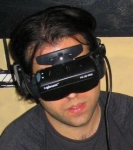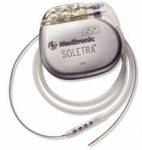Apr 29, 2006
Motor-evoked potentials following imagery and limb disuse
Motor-evoked potentials following imagery and limb disuse.
Int J Neurosci. 2006 May;116(5):639-51
Authors: Crews RT, Kamen G
18:56 Posted in Mental practice & mental simulation | Permalink | Comments (0) | Tags: Positive Technology
Apr 28, 2006
Playdocam
PlaydoCAM™ is a free software that allows to use the web camera into a motion-tracking gaming device and play pong or basketball on Mac or PC without installing any new software by the interface mechanism of waving the hands in the air. I tried it and it worked fine...
I think that this technology could be effectively used in home-based training for poststroke hemiplegia
17:40 Posted in Cybertherapy | Permalink | Comments (0) | Tags: Positive Technology
April issue of CyberPsychology & Behavior is online
From the CP&B website

| TIES that BIND: An Introduction to Domain Mapping as a Visualization Tool for Virtual Rehabilitation Patrice L. (Tamar) Weiss, Rochelle Kedar, Meir Shahar |
| Feasibility, Motivation, and Selective Motor Control: Virtual Reality Compared to Conventional Home Exercise in Children with Cerebral Palsy C. Bryanton, J. Bossé, M. Brien, J. Mclean, A. McCormick, H. Sveistrup |
| Integrating Haptic-Tactile Feedback into a Video-Capture–Based Virtual Environment for Rehabilitation Uri Feintuch, Liat Raz, Jane Hwang, Naomi Josman, Noomi Katz, Rachel Kizony, Debbie Rand, Albert "Skip" Rizzo, Meir Shahar, Jang Yongseok, Patrice L. (Tamar) Weiss |
| Reaching within Video-Capture Virtual Reality: Using Virtual Reality as a Motor Control Paradigm Assaf Y. Dvorkin, Meir Shahar, Patrice L. (Tamar) Weiss |
| Virtual Reality in the Rehabilitation of the Upper Limb after Stroke: The User?s Perspective J.H. Crosbie, S. Lennon, M.D.J. McNeill, S.M. McDonough |
| Usability of the Remote Console for Virtual Reality Telerehabilitation: Formative Evaluation Jeffrey A. Lewis, Judith E. Deutsch, Grigore Burdea |
| The Rutgers Arm, a Rehabilitation System in Virtual Reality: A Pilot Study Manjuladevi Kuttuva, Rares Boian, Alma Merians, Grigore Burdea, Mourad Bouzit, Jeffrey Lewis, Devin Fensterheim |
| Responses to a Virtual Reality Grocery Store in Persons with and without Vestibular Dysfunction Susan L. Whitney, Patrick J. Sparto, Larry F. Hodges, Sabarish V. Babu, Joseph M. Furman, Mark S. Redfern |
| A Treadmill and Motion Coupled Virtual Reality System for Gait Training Post-Stroke Joyce Fung, Carol L. Richards, Francine Malouin, Bradford J. McFadyen, Anouk Lamontagne |
| Influences of the Perception of Self-Motion on Postural Parameters E.A. Keshner, K. Dokka, R.V. Kenyon |
| Immersive Virtual Reality as a Rehabilitative Technology for Phantom Limb Experience: A Protocol Craig D. Murray, Emma Patchick, Stephen Pettifer, Fabrice Caillette, Toby Howard |
| Motor Training in the Manipulation of Flexible Objects in Haptic Environments I. Goncharenko, M. Svinin, Y. Kanou, S. Hosoe |
| Using Virtual Environment to Improve Spatial Perception by People Who Are Blind Orly Lahav |
| The Jerusalem TeleRehabilitation System, a New Low-Cost, Haptic Rehabilitation Approach Heidi Sugarman, Ehud Dayan, Aviva Weisel-Eichler, Joseph Tiran |
| Human Experience Modeler: Context-Driven Cognitive Retraining to Facilitate Transfer of Learning C.M. Fidopiastis, C.B. Stapleton, J.D. Whiteside, C.E. Hughes, S.M. Fiore, G.A. Martin, J.P. Rolland, E.M. Smith |
| Application of Virtual Reality Graphics in Assessment of Concussion Semyon Slobounov, Elena Slobounov, Karl Newell |
| Virtual Reality Pencil and Paper Tests for Neglect: A Protocol Kenji Baheux, Makoto Yoshizawa, Kazunori Seki, Yasunobu Handa |
| Virtual and Physical Toys: Open-Ended Features for Non-Formal Learning Eva Petersson, Anthony Brooks |
| Three-Dimensional Virtual Environments for Blind Children Jaime Sánchez, Mauricio Sáenz |
| Effectiveness of Virtual Reality for Pediatric Pain Distraction during IV Placement Jeffrey I. Gold, Seok Hyeon Kim, Alexis J. Kant, Michael H. Joseph, Albert "Skip" Rizzo |
| Simulating Social Interaction to Address Deficits of Autistic Spectrum Disorder in Children Cheryl Y. Trepagnier, Marc M. Sebrechts, Andreas Finkelmeyer, Willie Stewart, Jordana Woodford, Maya Coleman |
| Starting Research in Interaction Design with Visuals for Low-Functioning Children in the Autistic Spectrum: A Protocol Narcís Parés, Anna Carreras, Jaume Durany, Jaume Ferrer, Pere Freixa, David Gómez, Orit Kruglanski, Roc Parés, J. Ignasi Ribas, Miquel Soler, Àlex Sanjurjo |
| Virtual Reality Assessment of Medication Compliance in Patients with Schizophrenia Elizabeth K. Baker, Matthew Kurtz, Robert S. Astur |
| Reality Check: The Role of Realism in Stress Reduction Using Media Technology Y.A.W. de Kort, W.A. Ijsselsteijn |
| Hippocampus Function Predicts Severity of Post-Traumatic Stress Disorder Robert S. Astur, Sarah A. St. Germain, David Tolin, Julian Ford, David Russell, Mike Stevens |
| BusWorld: Designing a Virtual Environment for Post-Traumatic Stress Disorder in Israel: A Protocol Naomi Josman, Eli Somer, Ayelet Reisberg, Patrice L. (Tamar) Weiss, Azucena Garcia-Palacios, Hunter Hoffman |
| Simulation and Virtual Reality in Medical Education and Therapy: A Protocol Michael J. Roy, Deborah L. Sticha, Patricia L. Kraus, Dale E. Olsen |
| Virtual Reality Applications to Agoraphobia: A Protocol Georgina Cárdenas, Sandra Muñoz, Maribel González, Guillermo Uribarren |
17:25 Posted in Cybertherapy | Permalink | Comments (0) | Tags: Positive Technology
Functions of the Mirror Neuron System: Implications for Neurorehabilitation
Functions of the Mirror Neuron System: Implications for Neurorehabilitation.
Cogn Behav Neurol. 2006 Mar;19(1):55-63
Authors: Buccino G, Solodkin A, Small SL
Mirror neurons discharge during the execution of hand object-directed actions and during the observation of the same actions performed by other individuals. These neurons were first identified in the ventral premotor cortex (area F5) and later on in the inferior parietal lobule of monkey brain, thus constituting the mirror neuron system. More recently, mirror neurons for mouth object-directed actions have also been found in the monkey. Several pieces of experimental data demonstrate that a mirror neuron system devoted to hand, mouth, and foot actions is also present in humans. In the present paper we review the experimental evidence on the role of the mirror neuron system in action understanding, imitation learning of novel complex actions, and internal rehearsal (motor imagery) of actions. On the basis of features of the mirror neuron system and its role in action understanding and imitation, we discuss the possible use of action observation and imitation as an approach for systematic training in the rehabilitation of patients with motor impairment of the upper limb after stroke.
17:16 Posted in Mental practice & mental simulation | Permalink | Comments (0) | Tags: Positive Technology
Mental imagery in the acquisition of surgical skills
Cognitive skills analysis, kinesiology, and mental imagery in the acquisition of surgical skills.
J Otolaryngol. 2005 Oct;34(5):328-32
Authors: Bathalon S, Dorion D, Darveau S, Martin M
GOAL: Isolate and evaluate the impact of mental imagery on the acquisition of an emergency surgical technique. METHOD: We studied 44 first-year medical students performing a cricothyrotomy on a mannequin to determine the impact of teaching using mental imagery (MI) and/or kinesiology (KG) compared to the standard Advandec Trauma Life Support (ATLS) approach. Students were randomly assigned to one of three groups: MI and KG, KG alone or control (ATLS). Two weeks after the one-hour teaching session, they were evaluated with an OSCE testing the performance of the different steps of the technique, the time required and its fluidity. RESULTS: Total results (maximum: 25 marks) are as follows: KG + MI = 20.3 +/- 1.5 ; KG = 19.3 +/- 2.9 ; ATLS = 18.2 +/- 2.5. The only statistically significant difference for total results was in the use of MI and KG compared to the control group. Kinesiology alone or with mental imagery improved the fluidity of the performance. CONCLUSION: Many factors influence the acquisition of a surgical technique. This study showed that acquisition and performance of an emergency procedure (cricothyrotomy) was improved when mental imagery and kinesiology were combined to teach it.
17:15 Posted in Mental practice & mental simulation | Permalink | Comments (0) | Tags: Positive Technology
Simulating social interaction to address deficits of autistic spectrum disorder in children
Simulating social interaction to address deficits of autistic spectrum disorder in children.
Cyberpsychol Behav. 2006 Apr;9(2):213-7
Authors: Trepagnier CY, Sebrechts MM, Finkelmeyer A, Stewart W, Woodford J, Coleman M
Autistic spectrum disorder (ASD) is diagnosed on the basis of impairment in reciprocal social interaction and language, and rigidity of behavior. This brief paper describes the development of an experimental intervention for preschool children newly diagnosed with ASD. The rationale for this intervention is the hypothesis that failure to attend to social cues in very early life, of itself, may bear a large share of responsibility for core social and communicative deficits. The intervention, therefore, uses eye-tracking to monitor and trigger rewards for attention to facial expression and direction of gaze.
17:13 Posted in Cybertherapy | Permalink | Comments (0) | Tags: Positive Technology
Neurofeedback treatment of epilepsy
Neurofeedback treatment of epilepsy: from basic rationale to practical application.
Expert Rev Neurother. 2006 Feb;6(2):247-57
Authors: Egner T, Sterman MB
The treatment of epilepsy through operant conditioning of the sensorimotor rhythm electroencephalogram has a 35-year history. Neurophysiological studies have shown that this phasic oscillation reflects an inhibitory state of the sensorimotor system. Operant learning of sensory motor rhythm production results in an upregulation of excitation thresholds within the thalamocortical sensory and motor circuitry, which in turn is associated with reduced susceptibility to seizures. The clinical benefits derived from this neurofeedback training protocol, particularly in patients that are nonresponsive to pharmacotherapy, have been documented in many independent laboratories. Recent advances in computer technology have resulted in the availability of relatively inexpensive high-quality equipment for the application of neurofeedback therapy, thus presenting a viable and promising treatment alternative to the interested clinician.
17:11 Posted in Biofeedback & neurofeedback | Permalink | Comments (0) | Tags: Positive Technology
Apr 27, 2006
Researchers develop thought-controlled limbs
From VRoot.org (via MSNBC)
With Pentagon support, researchers develop thought-controlled limbs. Work on artificial arms that would be controlled by the human mind is ramping up, thanks to a helping financial hand from the Defense Advanced Research Projects Agency. DARPA announced in February that it would pour $55 million into a prosthetic arm research project to be led by Johns Hopkins University’s Applied Physics Laboratory. The work will be spread among more than two dozen institutions.
23:10 Posted in Neurotechnology & neuroinformatics | Permalink | Comments (0) | Tags: Positive Technology
Mobile VR Glasses
From 3pointd.com:

SpatiaLight, which manufactures “ultra high-resolution Liquid Crystal on Silicon (LCoS) microdisplays for the high definition television market,” has a press release accouncing that it’s now developing “a 3-D eyeglass-type display device for use with wireless phones, personal digital assistants and personal media players, which enable the viewing of broadband content, cable and satellite television, music videos as well as playing of video games, all with the experience of high definition large screen television.” Imagine: instead of all the laptops at Starbucks, we’ll one day see a bunch of people logging into the virtual world via a hyper-powered Blackberry and their SpatiaLight VR glasses.
23:10 Posted in Virtual worlds | Permalink | Comments (0) | Tags: Positive Technology
Mobile phone may impair your ability to make snap decisions
From textually.org
Electromagnetic radiation from your mobile phone may impair your ability to make snap decisions, such as when driving a car, an Australian study shows, reports Optus.net via Engadget Mobile and Techdirt Wireless.
"The study, which will be published in the journal Neuropsychologia found evidence of slowed reactions, on both simple reactions and more complex reactions, such as choosing a response when there is more than one alternative.
The researchers found these effects after people were exposed to electromagnetic radiation equivalent to spending 30 minutes on the phone."
... Another interesting finding of the study was that the participants showed a slight improvement in working memory, such as remembering a phone number long enough to dial it."
23:07 Posted in Wearable & mobile | Permalink | Comments (0) | Tags: Positive Technology
Deep Brain Stimulation Shows Promise in Treatment of Obsessive Compulsive Disorder

DBS has been used to treat intractable pain for several decades, and more recently, use of this technology has expanded to the FDA-approved indications for Parkinson’s disease and other movement disorders. DBS is also under investigation in the treatment of epilepsy and other debilitating neurological conditions. DBS surgery involves the placement of tiny implantable electrodes into specific parts of the brain that are functioning abnormally. These electrodes emit tiny pulses of electrical stimulation to block the abnormal activity in the brain, which causes a variety of symptoms – such as pain, tremors, movement problems; as well as obsessions, moods and anxieties associated with psychiatric disorders. The success of DBS is dependent on the surgical team’s ability to precisely pinpoint the specific brain area for stimulation. The advantage of DBS is that it is reversible, nondestructive, and can be modified by adjustment of the stimulator settings after implantation.
This study was conducted with Institutional Review Board (IRB) and Food and Drug Administration (FDA) Investigational Device Exemptions (IDE) approval. Six patients, four females and two males, with an average age of 48, were enrolled in the study from 2003 to 2005. All six patients had a history of being highly resistant to other treatments, including medication, psychotherapy, and electroconvulsive therapy (ECT). Bilateral DBS leads were implanted stereotactically in a region of the brain known as the ventral anterior internal capsule. Participants underwent standardized and detailed psychiatric, quality-of-life, and neuropsychological assessments on a regularly scheduled basis, both pre- and postsurgically.
At a minimum of six months postsurgery, four of the six patients showed a clinically significant reduction in depression severity of 50 percent or greater on the Montgomery-Asberg Depression Rating Scale. Quality-of-life measures improved as well, and patients showed progressive improvements in mood and functioning over time. One patient experienced persistent occipital pain that was alleviated with repositioning of a subcutaneous connector wire.
22:58 Posted in Neurotechnology & neuroinformatics | Permalink | Comments (0) | Tags: Positive Technology
Your Thoughts Are Your Password
17:50 Posted in Brain-computer interface | Permalink | Comments (0) | Tags: Positive Technology
Apr 26, 2006
Neural interfaces for gaming
Via VRoot
Mercurynews reports that at least two start-ups have developed technology that monitors a player's brain waves and uses the signals to control the action in games. They hope it will enable game creators to immerse players in imaginary worlds that they can control with their thoughts instead of their hands.
San Jose's NeuroSky has been testing prototypes of its system that uses a sensor-laden headband to monitor brain waves, and then uses the signals to control the interaction in video games. They hope that such games are just the beginning of a mind-machine interface with many different applications.

Read the full story
22:47 Posted in Brain-computer interface | Permalink | Comments (0) | Tags: Positive Technology
Idearium
22:31 | Permalink | Comments (0) | Tags: Positive Technology
Simulator Allows Doctors To Experience Heart Failure
Doctors and nurses who treat heart-failure patients get a chance to feel and experience what heart failure is really like.
Symptoms of heart failure include difficulty breathing, feeling tired, heart palpitations and tightness in the chest.
Doctors and nurses are placed inside Heart FXPod [<http://www.heartfxpod.com/>], created for Astra-Zeneca, which simulates what it is like for their patients.
They use the pedals to walk like a heart-failure patients and use headphones to be trapped in the patient's world
The doctors and nurses are strapped in a pneumatic vest that inflates and suddenly makes it difficult for them to breathe.
It is virtual reality, but it is a little more real than some might like.
"Severe chest tightness. So now I know what my patients go through," said Dr. Siva Srinivasan, of Thomas Jefferson University Hospital.
Srinivason said that after the simulator, he might treat his patients differently.
The Heart FXPod is a multi-sensory interactive simulation that leaves you with no doubt what it's like when your heart fails to provide enough oxygen and blood flow to your body.
If someone trying the pod gets scared they have the ability to stop it.
Dr. Paul Mather directs the Advanced Heart Failure Center at the Jefferson Heart Institute.
"Everyone has sympathy towards other human beings. I think that's part of our human element. But empathy, where you can actually feel what another person is going through as opposed to just feeling sorry for them, is different. I think if we can marry that feeling to the science of medicine, it will make for a better health care provider," Mather said.
Mather said that about 15 years ago, heart failure was a death sentence. Now, doctors can help it regress and patients can often end up living good lives.
15:08 Posted in Cybertherapy | Permalink | Comments (0) | Tags: Positive Technology
Apr 25, 2006
Is technology changing our brains?
From Smart Mobs
Neuro-biologist Susan Greenfield asked this interesting question:
" In just a couple of decades, we have slipped away from a culture based essentially on words to one based essentially on images, or pictures. This is probably one of the great shifts in the story of modern humans but we take it almost for granted.There can be little doubt that the structures, never mind the surface form, of the English language are changing fast.
The process of traditional book-reading, which involves following an author through a series of interconnected steps in a logical fashion. We read other narratives and compare them, and so "build up a conceptual framework that enables us to evaluate further journeys... One might argue that this is the basis of education ... Traditional education, she says, enables us to "turn information into knowledge."
Put like that, it is obvious where her worries lie. The flickering up and flashing away again of multimedia images do not allow those connections , and therefore the context, to build up. ...
23:40 Posted in Persuasive technology | Permalink | Comments (0) | Tags: Positive Technology
Text messaging in psychotherapy
From Smart Mobs
Instant messaging, favored by chatting teens and office gossips, is a growing tool for therapists counseling people on everything from smoking cessation to sexual-abuse trauma, reports the Pioneer Press.
Proponents say the text-based conversations are appealing because they're fast and anonymous — users can log onto a number of online services and connect with therapists who know them only by screen names. But many in the mental-health community say the format is too impersonal for effective treatment and should be only an adjunct to face-to-face counseling.... Text messaging, critics say, doesn't allow therapists to pick up on important visual cues to a patient's true state of mind.
"What one gleans as a psychiatrist in a clinical assessment is not just from the words one says but from the emotions," says Paul Appelbaum, a psychiatry professor at Columbia University and past president of the American Psychiatric Association. He says doctors need to assess the way a person walks, sits, smiles or tears up.
23:38 Posted in Cybertherapy | Permalink | Comments (0) | Tags: Positive Technology
Toward brain correlates of natural behavior: fMRI during violent video games
Toward brain correlates of natural behavior: fMRI during violent video games.
Hum Brain Mapp. 2006 Apr 20;
Authors: Mathiak K, Weber R
Modern video games represent highly advanced virtual reality simulations and often contain virtual violence. In a significant amount of young males, playing video games is a quotidian activity, making it an almost natural behavior. Recordings of brain activation with functional magnetic resonance imaging (fMRI) during gameplay may reflect neuronal correlates of real-life behavior. We recorded 13 experienced gamers (18-26 years; average 14 hrs/week playing) while playing a violent first-person shooter game (a violent computer game played in self-perspective) by means of distortion and dephasing reduced fMRI (3 T; single-shot triple-echo echo-planar imaging [EPI]). Content analysis of the video and sound with 100 ms time resolution achieved relevant behavioral variables. These variables explained significant signal variance across large distributed networks. Occurrence of violent scenes revealed significant neuronal correlates in an event-related design. Activation of dorsal and deactivation of rostral anterior cingulate and amygdala characterized the mid-frontal pattern related to virtual violence. Statistics and effect sizes can be considered large at these areas. Optimized imaging strategies allowed for single-subject and for single-trial analysis with good image quality at basal brain structures. We propose that virtual environments can be used to study neuronal processes involved in semi-naturalistic behavior as determined by content analysis. Importantly, the activation pattern reflects brain-environment interactions rather than stimulus responses as observed in classical experimental designs. We relate our findings to the general discussion on social effects of playing first-person shooter games. Hum. Brain Mapping 2006. (c) 2006 Wiley-Liss, Inc.
23:35 Posted in Cybertherapy | Permalink | Comments (0) | Tags: Positive Technology
VRoot.org -: Neural Interfaces: Scientists Probe the Use of the Tongue
PENSACOLA, Fla. - In their quest to create the super warrior of the future, some military researchers aren't focusing on organs like muscles or hearts. They're looking at tongues. By routing signals from helmet-mounted cameras, sonar and other equipment through the tongue to the brain, they hope to give elite soldiers superhuman senses similar to owls, snakes and fish.
23:27 Posted in Neurotechnology & neuroinformatics | Permalink | Comments (0) | Tags: Positive Technology
Video introducing eyetracking
23:24 Posted in Research tools | Permalink | Comments (0) | Tags: Positive Technology









